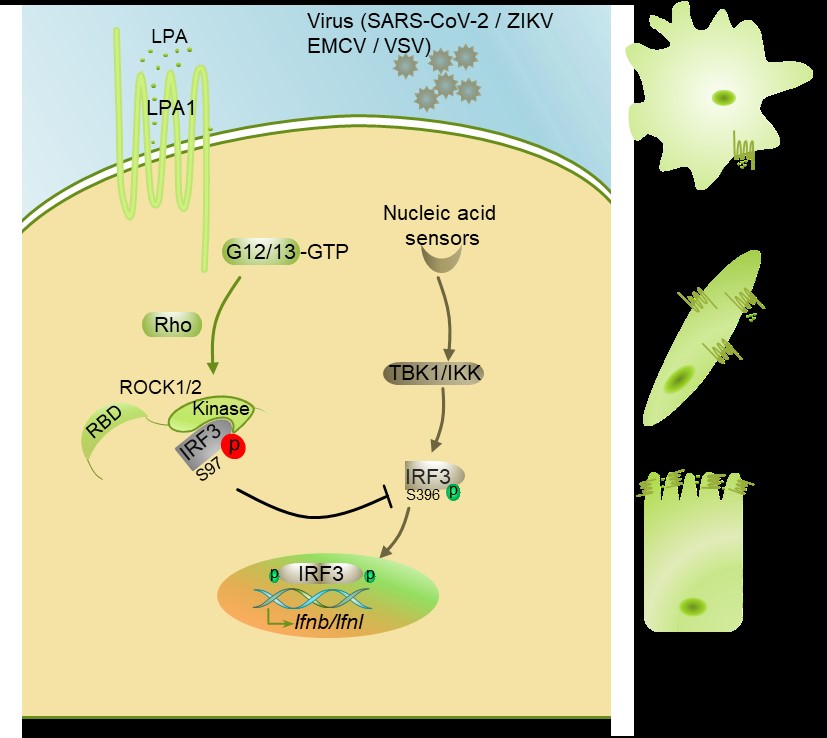Science Advances published the collaborated work online, which is titled “Targeting lysophospholipid acid receptor 1 and ROCK kinases promotes antiviral innate immunity”. Dr. WANG Hongyan from Shanghai Institute of Biochemistry and Cell Biology & Hangzhou Institute for Advanced Study, University of Chinese Academy of Sciences, Dr. WANG Jianwei from Institute of Pathogen Biology, Chinese Academy of Medical Sciences and Peking Union Medical College, and Prof. WEI Bin from Shanghai University are the corresponding authors. Drs ZHANG Chi and LI Weiyun are the first authors. This article has elucidated that targeting lysophospholipid acid receptor 1 (LPA1) promotes innate immunity against various kinds of viral infections, which provides a potential antiviral drug target.
Innate immune cells produce interferon (IFN) against viral infection, and growing evidence indicates the key role of lipid metabolites in the regulation of antiviral responses. Several reports have identified that plasma concentrations of lysophosphatidic acid (LPA) are enhanced in HCV-infected and coronavirus disease 2019 (COVID-19) patients. LPA binds with the G protein–coupled receptors (GPCR) including LPA1-6, which could promote cell migration or proliferation in tumor cells and epithelial cells. However, it is unclear whether and how LPA1 signaling manipulates the innate antiviral responses.
The researchers found that upon virus infection, addition of LPA could suppress type I/III interferon (IFN-I/III) production and promote viral replication in epithelial cells and macrophages. Interestingly, among the 6 receptors, LPA1 expression was specifically elevated upon viral infection. After silencing LPA1, LPA treatment failed to show the inhibitory effect on IFN expression, suggesting that LPA inhibited antiviral responses via LPA1. In the intestinal organoids and macrophages, targeting LPA1 with the LPA1 inhibitors could promote IFN expression and viral clearance. Furthermore, targeting LPA1 with these inhibitors in vivo or conditional knockout Lpa1 in small intestine could enhance IFN production and viral clearance to increase the survival rates upon mice were infected with different viruses. Interestingly, LPA1 was colocalized with the SARS-CoV-2 receptor ACE2 in lung and small intestine. LPA1 inhibitors also suppressed SARS-CoV-2 replication in lung Calu-3 cells, indicating that targeting LPA1 could control viral dissemination specifically in the major organs infected by SARS-CoV-2.
Mechanistically, LPA1 repressed interferon regulatory factor 3 (IRF3) activation via the downstream effectors G12/13-Rho-associated coil kinase (ROCK). They have further elucidated that the ROCK kinase domain interacted with IRF3 and phosphorylates IRF3 at the inhibitory site serine 97. Treatment with the ROCK inhibitor enhanced IRF3 activation and antiviral responses.
Together, this article has uncovered that the LPA-LPA1 signaling inhibits viral infection-induced IFN production via ROCK, which promotes phosphorylation of IRF3 S97. Since the LPA1 inhibitors are currently suggested as a preclinical drug to treat lung or liver fibrosis, this work might provide a new application that targeting LPA1 could enhance the host innate immunity against viral infection via increasing IFN production and protection of viral-infected organs.

Contact: hongyanwang@sibcb.ac.cn
Reference: http://doi.org/10.1126/sciadv.abb5933
 Appendix:
Appendix: